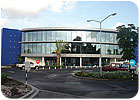
Temperature cascades, demanding absolute humidity conditions, high energy costs, and power supply parameters presented some logistical challenges to the designers of this tropical office building. A single-pipe hydronic system helped alleviate their concerns.
A new office building housing some 200 employees of KPMG, the global audit, tax, and advisory services firm, is up and running on the island of Curaçao in the Netherlands Antilles, and it’s being kept cool by an innovative HVAC system.
In planning the new building, KPMG approached local engineering and installation firm, Omni B.V., to design an HVAC system that would save energy, include an advanced locally supportable BMS, operate quietly (noise levels from mechanical rooms and air distribution systems under 29 dBA), meet precise indoor comfort conditions (71.5°F and +50% rh, and CO2below 900 ppm), provide individual space controls through the BMS (no thermostats), and be green.
The most critical requirement - and the most challenging according to Omni B.V.’s engineering director, Henk Soeterboek, was consuming as little energy as possible, since Curaçao has one of the highest energy costs per kW in the world ($0.33 per kW).
Another challenge, Soeterboek said, was that, “The building was unique in the sense that the interior panels had to be removable so the spaces could be either increased or decreased in area without any consequence of air distribution thermostats, etc.”
Global Specifying
In keeping with KPMG’s global presence Omni B.V. specified equipment from world-class suppliers:- Daikin chillers – Belgium
- Helpman condensers – Netherlands
- Carrier modular air handlers – Brazil
- ASI Controls for the BMS system – U.S.
- Solid Air distribution supply grilles – Netherlands
- Thermacore cold water pipe – U.S.
- Taco LoadMatch system – U.S.
Selection of specific LoadMatch circulators - there are 13 total in the building - was based on the power supply parameters in Curaçao - 400/3/50Hz. “We had to select the circulators carefully,” Soeterboek said. “Due to flow volume and head, the circulators needed to be slightly bigger than standard size. All pumps were selected from Taco. In practice, this worked out very well.”
Tussling With Tropical Humidity
On the island of Curaçao, absolute humidity averages between 22 to 24 grams/kg (+180 grains/lb of dry air). Outdoor climate conditions place a very high load on A/C systems, especially the fresh air requirements. Careful selection of the air-handling equipment was required due to the rh requirements, and heat recovery equipment was a must not only for rh, but also for energy savings.Relative humidity in the building was an upfront concern for Omni B.V. because of dynamically changing water temperatures - the temperature cascade - experienced by the LoadMatch system. However, those concerns were effectively answered with proper sizing of the cooling coils - to account for the cascade and system diversity from one installation to the next - humidity levels in LoadMatch-equipped buildings have been very good.
“After careful analysis and support from Taco,” said Soeterboek, “we were convinced that humidity problems were not going to be a major issue with the LoadMatch system.”
To date, “the building feels very comfortable, and load shifting from one side of the building to the other side takes place without any complaints,” Soeterboek said.
An Effective Combo
The combination of Daikin chillers and Helpman condensers made for a very efficient package of COP > 3.45 at full load. The chillers were placed in a remote underground equipment room because cooling towers, considering the high price of water on Curaçao, were not feasible. The building total COP is + 3.1 taking into account all additional loads like the 13 air handler motors at 3 hp each; the BMS, and 13 recirculating LoadMatch pumps at _ hp each.“Our experience with chilled water system is that the TAB can take a considerable amount of time. With the Load-Match system this was reduced considerably. We spent only about 30% of the time that would have otherwise been necessary,” Soeterboek added.
He reported that the system has been a success, and since start-up there has been no need to balance any water flows. In fact, during its first nine months of operation, the building remained right on design specifications, and the Omni engineers were extremely happy with the results.ES
